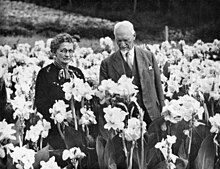Isie Smuts | |
|---|---|
 Isie and Jan Smuts, 1941 | |
| Born | Sybella Margaretha Krige 22 December 1870 Stellenbosch, Cape Colony, British Empire |
| Died | 25 February 1954 (aged 83) |
| Other names | Isie Krige, Isie Smutts |
| Occupation(s) | Teacher, farmer, First Lady of South Africa |
| Years active | 1891–1948 |
Sybella "Isie" Margaretha Smuts (née Krige, also known as Ouma Smuts; 22 December 1870 — 25 February 1954) was the second First Lady of the Union of South Africa, and a teacher, farmer, charity organiser and scrapbooker. She grew up in the British Cape Colony and qualified as a teacher in 1891. She taught for six years before marrying Jan Smuts, who later became the second Prime Minister of the Union of South Africa. She was a staunch supporter of Afrikaner nationalist aims to break free of British rule. Smuts eventually supported her husband's efforts to bring reconciliation to the Dutch and English communities and the creation of the self-governing union. During the Second Boer War (1899–1902) and World War I she supplied care parcels to inmates and soldiers. When the war ended, she was active in the Suid-Afrikaanse Vrouefederasie (South African Women's Federation), a social welfare service for war widows and orphans.
In 1909, the couple settled on the Doornkloof farm (known in English as The Big House) in Irene township outside Pretoria. She raised their six surviving children there and during her husband's extended absences on matters of state, she was the primary administrator of the farn. In the evenings when the family retired, she clipped articles from media sources written about Jan and organised them into scrapbooks. Smuts preferred to remain outside the public sphere and rarely joined her husband in any official capacity until his second term as prime minister began in 1939. She then became a leader in the Women's United Party, an affiliate of the United Party of South Africa. During World War II, she became a public figure. She spoke out against fascism and supported the creation of the Women's International Democratic Federation, an organisation aimed at preventing war and furthering women's rights. She participated in radio broadcasts and wrote articles to urge support for the war effort, accompanied her husband on troop inspection tours, brought soldiers care packages, and wrote letters for them.
In 1940, Smuts founded and chaired the Gifts and Comforts Fund, which raised money to provide servicemen with toiletries, sports equipment, and radios. Over the course of the war, the fund raised over a million pounds. Her war activities made her an icon and she became popularly known as the mother (or Ouma, grandmother) of South Africa. She received an honorary PhD from the University of the Witwatersrand in 1943 and in 1952 the South African Association of University Women created a research scholarship bearing her name. When Smuts died in 1954, her papers and scrapbook collections were donated to the South African State Archives. Microfilm copies of the Smuts Archive, which also includes Jan's records, are housed at the Universities of Cambridge and Cape Town. The Doornkloof farm was designated a National Monument by the Government of South Africa in 1969. A street in Pretoria was named in her honour.